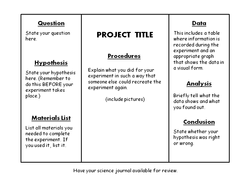
CELEBRATION OF SCIENCE
January 14th, 2026
Each year is a little different so keep an eye on this space for updates as they become available including calls for volunteers, donations and schedules.
Celebration of Science is a time when students are invited to explore and present a scientific topic of interest.
You can find the current packet for this year here.
Students are NOT required to participate, they are invited and encouraged to get involved.
Celebration of Science Parent Chair
Imee Del Mundo
Science Fair Saturday
w/Ms. Price
(3rd-6th)
Jan 12th
5pm @Ms. Price's Class
***NOTE UPDATED TIME***
You've done your project, but want someone to look it over to see if you've missed anything? Bring your boards for final review!
Science Fair Family Viewing
Jan 16th
4-6pm @Lee Library
Important Details:
-
All projects must be completed by Thursday, January 16th and brought to school in the morning.
-
Students will be working on their projects at home. Classroom time will not be provided.
-
Students in K-2nd will present in their classrooms on January 16th.
-
Students in 3-6 grade that are not participating in the Greater Austin Regional Science and Engineering Fair (GARSEF) will also present their projects in class.
-
3-6th grade students participating in the Science and Engineering fair will present their projects to a panel of judges outside of the classroom.
-
Parents and Caregivers are invited to view projects after school on January 16th.
Project Types

EXPERIMENT
Science Fair Experiments will continue to follow the requirements from Greater Austin Regional Science and Engineering Fair (GARSEF).The Elementary Division Handbook includes important information, guidelines, requirements and prohibited projects.

REPORT
Students will research a Science related topic chosen by the
student. They will write/type a minimum of 2 pages on this topic including a works cited resource page.

MODEL or DEMONSTRATION w/Paper or Media
(Not part of the Greater Austin Regional Science and Engineering
Fair)
Students will create a three dimensional model by hand or produce a media-based presentation of a Science related topic of their choosing. They will also write a one page report or media presentation (if age appropriate) describing how they made the model, how it works, what it represents, and why they chose to create it.
Projects Allowed at GARSEF
● Experiments - a student asks an experimental question, forms and tests a hypothesis, and makes conclusions. Example: I tested batteries to see which brand lasts the longest in a flashlight.
● Engineering Designs - a student sees a need, and then designs and creates a product to fill that need. Example: I tried to design a stronger bridge and here is how I did it and I learned this....
● Exhibits - a student has an item or items that they ask a question about or study in order to answer a question. Examples: Here is a toy windmill I bought and this is how it works. My question was "How does a windmill work?". Then by doing research and playing with it I learned this....Or This is my rock collection, this is how I organized it and why, this is what I learned about rocks..... (Exhibits or research papers are not encouraged in older grades, 5th - 6th. )
Project Board Guidelines
All student project boards must follow the guidelines in order to be allowed in the exhibit hall.
● Project display should be on sturdy tri-fold board available at local craft and office supply stores. Written material, drawings and pictures should be securely attached to the display board with glue or tape. Do not use staples: they will poke out the back of the board.
● Projects will be displayed on tables that are 36 inches high. Size of display area may not exceed the following measurements: 15” deep, 48” wide, and 72” high. Due to space limitations, displays that exceed these measurements cannot be accepted.
● Electricity for your display will not be available but you can use household batteries to power your project.
Allowed Items
● Photographs, drawings, stuffed animals/artificial plants or imitation (play) food should be used to depict the prohibited or discouraged items.
● Students should take photographs of project steps as a visual explanation of their effort. Students must ask permission before photographing other individuals for the display board.
● Be sure to properly credit/list all sources of graphics and photographers on the display board (“Photograph/Visuals by . . .”) This includes images from websites.
● Students may use a computer and printer for written parts of the project.
Discouraged Items
● Items for demonstrations. This is not a demonstration fair. Judges want to hear what the student has learned. Photographs of the project will suffice.
● Expensive, breakable or fragile items Items
Not Allowed
● No organisms; living, dead or preserved (no plants or animals) ● No water or chemicals, crystals, liquids ● No human/animal parts or body fluids (for example, blood, urine) ● No human or animal food ● No poisons, drugs, controlled or hazardous substances ● No sharp items (for example: syringes, needles, pipettes, knives, tacks, nails) ● No pressurized tanks or containers ● No glass or glass objects unless part of a commercial product (eg: a computer screen) ● No batteries with open top cells (so that battery acid can be seen) ● No dirt, soil, gravel, rocks, sand, waste products, etc. ● No project, device, activity, or substance deemed hazardous to student health or safety ● No photographs or pictures of animals or people in surgical techniques, dissections or necropsies
Examples of Trifold Boards
 |  |  |
|---|---|---|
 |
Helpful Links:
-
Science Buddies : www.sciencebuddies.org
-
Britannica Online: http://school.eb.com/levels/elementary (no log-in necessary)
-
World Book Online: http://worldbookonline.com/student/home (no log-in necessary)
